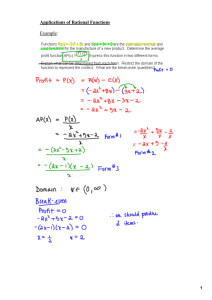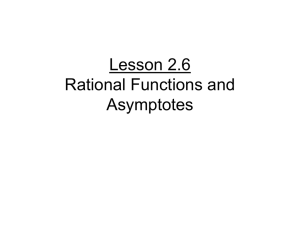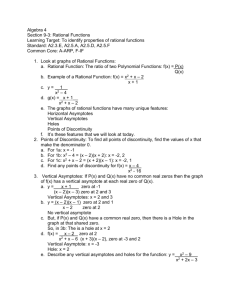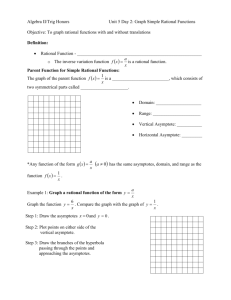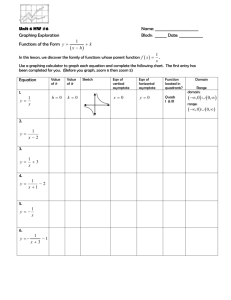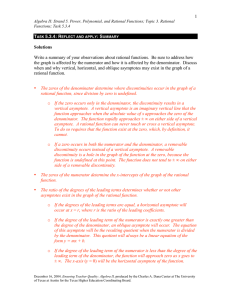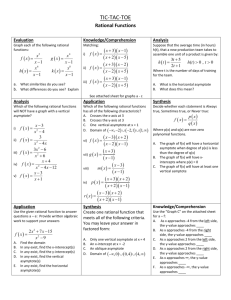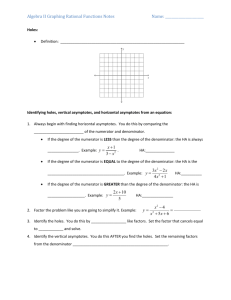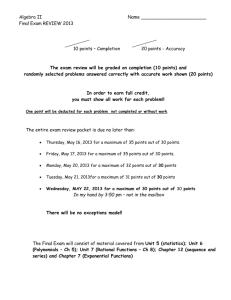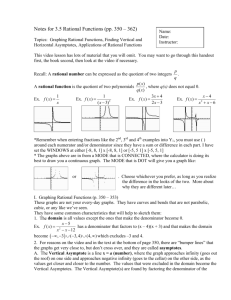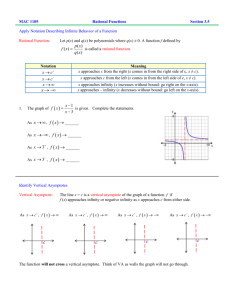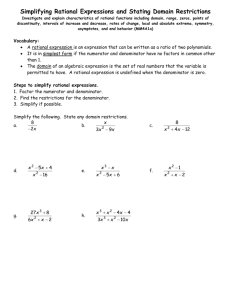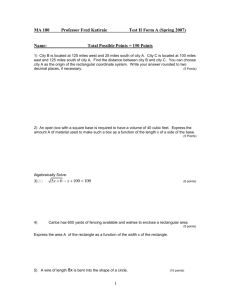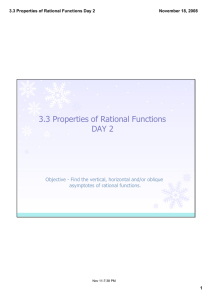4.2 Outline (WORD)
advertisement
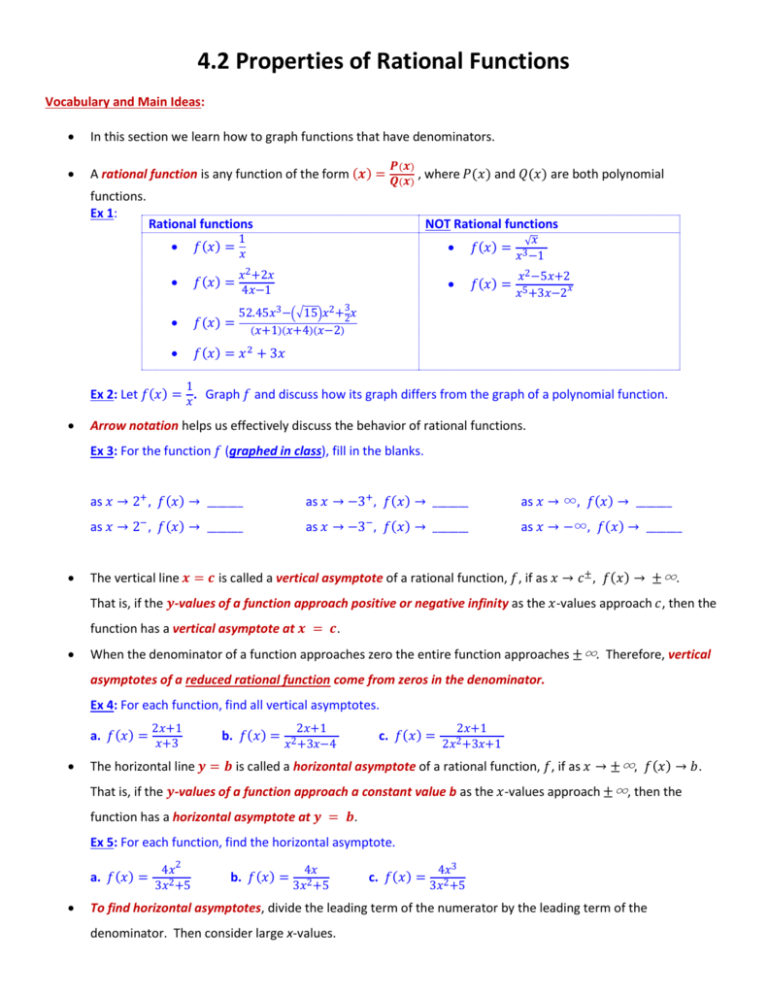
4.2 Properties of Rational Functions Vocabulary and Main Ideas: In this section we learn how to graph functions that have denominators. A rational function is any function of the form (𝒙) = functions. Ex 1: 𝑷 (𝒙 ) , where 𝑃(𝑥) and 𝑄(𝑥) are both polynomial 𝑸(𝒙 ) Rational functions NOT Rational functions 1 𝑓(𝑥) = 𝑥 𝑓(𝑥) = 4𝑥−1 52.45𝑥3 −(√15)𝑥2 +32𝑥 𝑓(𝑥) = (𝑥+1)(𝑥+4)(𝑥−2) 𝑓(𝑥) = 𝑥 2 + 3𝑥 𝑥2 +2𝑥 𝑓(𝑥) = √𝑥 𝑥3 −1 𝑓(𝑥) = 𝑥2 −5𝑥+2 𝑥5 +3𝑥−2𝑥 1 Ex 2: Let 𝑓(𝑥) = 𝑥. Graph 𝑓 and discuss how its graph differs from the graph of a polynomial function. Arrow notation helps us effectively discuss the behavior of rational functions. Ex 3: For the function 𝑓 (graphed in class), fill in the blanks. as 𝑥 → 2+ , 𝑓(𝑥) → _______ as 𝑥 → −3+ , 𝑓(𝑥) → _______ as 𝑥 → ∞, 𝑓(𝑥) → _______ as 𝑥 → 2− , 𝑓(𝑥) → _______ as 𝑥 → −3− , 𝑓(𝑥) → _______ as 𝑥 → −∞, 𝑓(𝑥) → _______ The vertical line 𝒙 = 𝒄 is called a vertical asymptote of a rational function, 𝑓, if as 𝑥 → 𝑐 ± , 𝑓(𝑥) → ±∞. That is, if the 𝒚-values of a function approach positive or negative infinity as the 𝑥-values approach 𝑐, then the function has a vertical asymptote at 𝒙 = 𝒄. When the denominator of a function approaches zero the entire function approaches ±∞. Therefore, vertical asymptotes of a reduced rational function come from zeros in the denominator. Ex 4: For each function, find all vertical asymptotes. 2𝑥+1 a. 𝑓(𝑥) = 𝑥+3 b. 𝑓(𝑥) = 2𝑥+1 𝑥2 +3𝑥−4 c. 𝑓(𝑥) = 2𝑥+1 2𝑥2 +3𝑥+1 The horizontal line 𝒚 = 𝒃 is called a horizontal asymptote of a rational function, 𝑓, if as 𝑥 → ±∞, 𝑓(𝑥) → 𝑏. That is, if the 𝒚-values of a function approach a constant value b as the 𝑥-values approach ±∞, then the function has a horizontal asymptote at 𝒚 = 𝒃. Ex 5: For each function, find the horizontal asymptote. a. 𝑓(𝑥) = 4𝑥2 3𝑥2 +5 b. 𝑓(𝑥) = 4𝑥 3𝑥2 +5 c. 𝑓(𝑥) = 4𝑥3 3𝑥2 +5 To find horizontal asymptotes, divide the leading term of the numerator by the leading term of the denominator. Then consider large x-values. When a rational function has a numerator that is of higher degree than the denominator, the function has an oblique asymptote. The oblique asymptote of a rational function is the quotient found when using long division. Ex 6: Find the oblique asymptote for the function. 𝑓(𝑥) = 𝑥3 −1 𝑥2 −9𝑥 More Examples: 1. Use the graph of 𝑓 to fill in the blanks. as 𝑥 → −2+ , 𝑓(𝑥) → _______ as 𝑥 → −2− , 𝑓(𝑥) → _______ as 𝑥 → 1+ , 𝑓(𝑥) → _______ as 𝑥 → 1− , 𝑓(𝑥) → _______ as 𝑥 → ∞, 𝑓(𝑥) → _______ as 𝑥 → −∞, 𝑓(𝑥) → _______ 2. For each rational function, find all asymptote (vertical, horizontal or oblique). a. 𝑓(𝑥) = 3𝑥+1 2𝑥−5 b. 𝑓(𝑥) = 3𝑥 4𝑥 2 −𝑥 c. 𝑓(𝑥) = 𝑥 2 −4𝑥+3 𝑥 2 −1 d. 𝑓(𝑥) = 𝑥 2 +𝑥+1 𝑥−1
